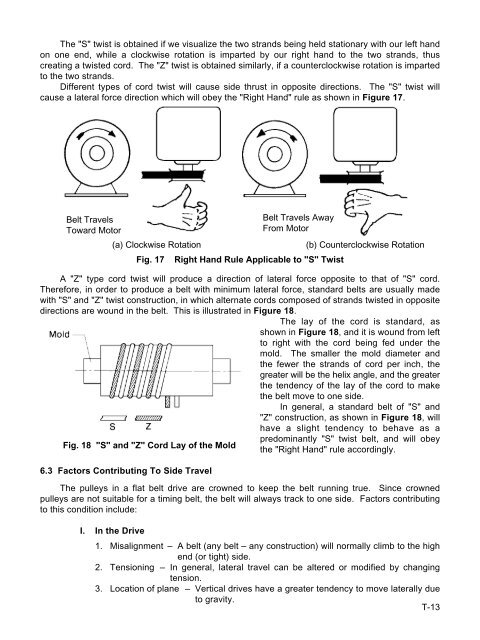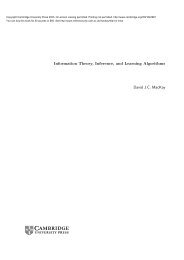THE WORLD OF TIMING BELTS - MAELabs UCSD
THE WORLD OF TIMING BELTS - MAELabs UCSD
THE WORLD OF TIMING BELTS - MAELabs UCSD
Create successful ePaper yourself
Turn your PDF publications into a flip-book with our unique Google optimized e-Paper software.
The "S" twist is obtained if we visualize the two strands being held stationary with our left hand<br />
on one end, while a clockwise rotation is imparted by our right hand to the two strands, thus<br />
creating a twisted cord. The "Z" twist is obtained similarly, if a counterclockwise rotation is imparted<br />
to the two strands.<br />
Different types of cord twist will cause side thrust in opposite directions. The "S" twist will<br />
cause a lateral force direction which will obey the "Right Hand" rule as shown in Figure 17.<br />
Belt Travels<br />
Toward Motor<br />
Belt Travels Away<br />
From Motor<br />
(a) Clockwise Rotation (b) Counterclockwise Rotation<br />
Fig. 17 Right Hand Rule Applicable to "S" Twist<br />
A "Z" type cord twist will produce a direction of lateral force opposite to that of "S" cord.<br />
Therefore, in order to produce a belt with minimum lateral force, standard belts are usually made<br />
with "S" and "Z" twist construction, in which alternate cords composed of strands twisted in opposite<br />
directions are wound in the belt. This is illustrated in Figure 18.<br />
The lay of the cord is standard, as<br />
shown in Figure 18, and it is wound from left<br />
to right with the cord being fed under the<br />
mold. The smaller the mold diameter and<br />
the fewer the strands of cord per inch, the<br />
greater will be the helix angle, and the greater<br />
the tendency of the lay of the cord to make<br />
the belt move to one side.<br />
In general, a standard belt of "S" and<br />
"Z" construction, as shown in Figure 18, will<br />
have a slight tendency to behave as a<br />
predominantly "S" twist belt, and will obey<br />
Fig. 18 "S" and "Z" Cord Lay of the Mold<br />
the "Right Hand" rule accordingly.<br />
6.3 Factors Contributing To Side Travel<br />
The pulleys in a flat belt drive are crowned to keep the belt running true. Since crowned<br />
pulleys are not suitable for a timing belt, the belt will always track to one side. Factors contributing<br />
to this condition include:<br />
I. In the Drive<br />
1. Misalignment – A belt (any belt – any construction) will normally climb to the high<br />
end (or tight) side.<br />
2. Tensioning – In general, lateral travel can be altered or modified by changing<br />
tension.<br />
3. Location of plane – Vertical drives have a greater tendency to move laterally due<br />
to gravity.<br />
T-13
















